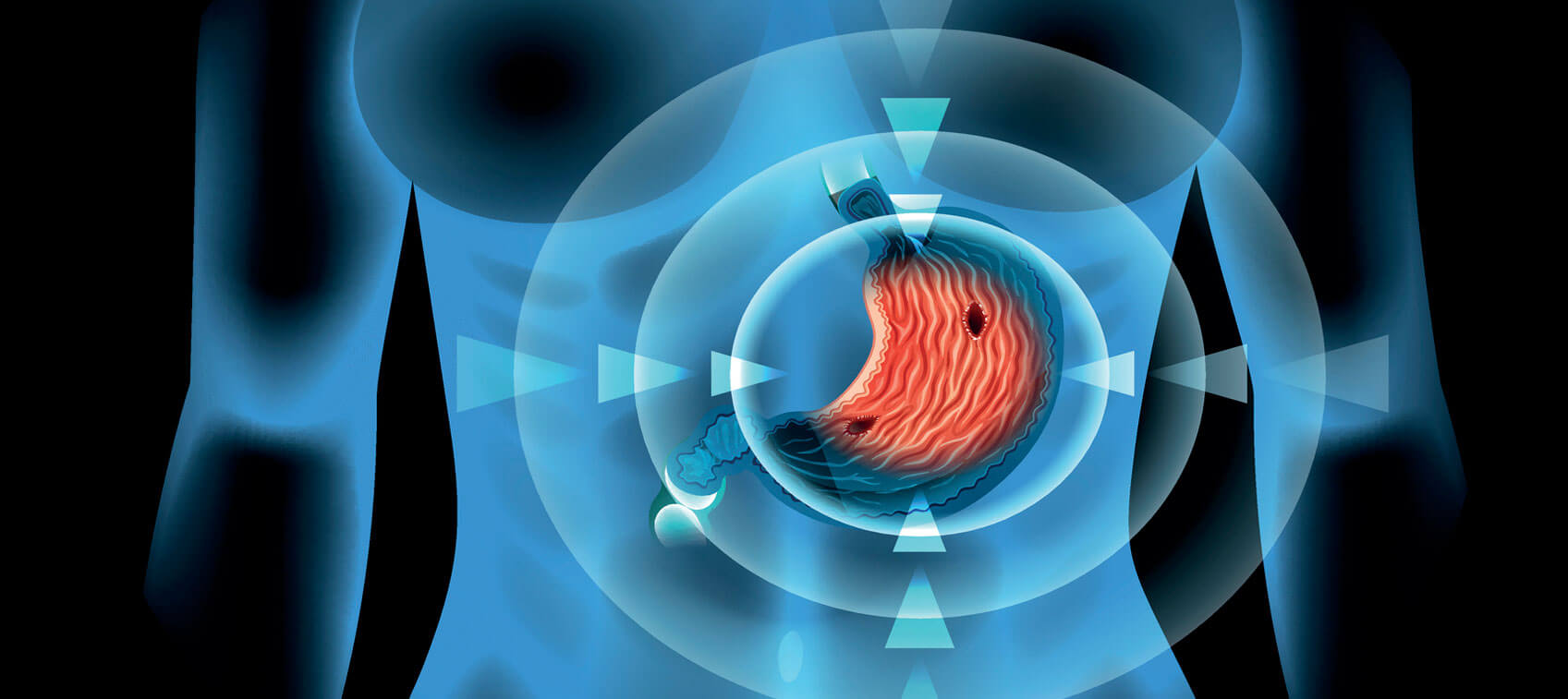
Ulcers are basically sores that develop in the lining of the digestive tract. These sores are spots where the stomach’s or intestine's lining has been eaten away by stomach acid and digestive juices. Ulcers typically heal and recur.
There are a few types of ulcers, and in general, the names of the ulcers specify where they are found. An ulcer in the part of the small intestine called the duodenum is known as a duodenal ulcer, while a stomach ulcer is commonly referred to as a peptic ulcer. Symptoms will depend on where the ulcer is located and can vary widely. Some people may have no symptoms while others experience an intermittent burning and gnawing sensation along with feeling empty and hungry.
What Can Cause a Stomach Ulcer?
Just as there are different types of ulcers, there are also different mechanisms that can cause them. Here are some factors that can contribute to ulcer development:
- Helicobacter pylori bacterium. An overgrowth of the bacterium Helicobacter pylori (H. pylori) can contribute to the development of stomach ulcers. Normal populations of these bacteria, however, have been shown to provide a protective effect for the esophagus. It is, therefore, important not to eliminate H. pylori entirely from the body as a quick fix for treating ulcers.
- Certain drugs. Nonsteroidal anti-inflammatory drugs such as aspirin and ibuprofen, cortisone derivatives, and alcohol have all been linked to ulcer development. These drugs cause injury to the protective mucosal lining of the stomach, which results in ulceration and bleeding.
- Low melatonin levels. Another cause of ulcers you rarely, if ever, hear mentioned is low melatonin levels. The trigger for melatonin production in the pineal gland is low light levels. As our society stays up later, uses artificial lighting far into the night, and gets less sleep, our bodies produce less melatonin. Decreased melatonin production has been linked to several health problems including the development of ulcers. Animal studies have shown that increasing melatonin levels by even small amounts can have a dramatic effect in both healing and preventing stress-induced ulcers.
Eliminating H. pylori Is a Mistake
Several years ago, the H. pylori bacterium was claimed to be the primary cause of stomach ulcers. Consequently, total elimination of H. pylori from the body through the use of antibiotics has become the conventional medical treatment of choice for ulcers in the stomach and small intestine.
Eliminating H. pylori often does let ulcers heal, but researchers (and patients) are discovering that people who have completely killed off H. pylori colonies subsequently develop gastroesophageal reflux. H. pylori in the digestive tract helps protect against acid erosion of the esophagus and small intestine.
This conventional medical ulcer treatment of selectively wiping out the H. pylori strain of bacteria with antibiotics ultimately disrupts the balance of bacteria in the gut and leads to other digestive problems. A more reasonable solution is to restore gut health by improving bacterial balance and using natural treatments for stomach ulcers.
Natural Treatments for Stomach Ulcers
If you suffer from ulcers, try the following natural treatments...
Vitamin E
Doctors at the Kiev Medical Institute reported that 300 mg of vitamin E daily effectively treated peptic ulcers of 28 patients. Ulcers were relieved in four to six days in the vitamin E group, while it took seven to ten days in those given conventional medication. Patients taking vitamin E also had increased protein repair in their intestinal linings and gained from 1.5 to 3 kg during the study, while the controls did not gain any weight.
Bananas
The sitoindosides in dried, unripe bananas increase mucus in the digestive tract, which provides a strong protective coating to help prevent and heal ulcers. Unripe bananas also promote cell growth in the intestinal tract. And bananas contain water-soluble polysaccharides, the same compounds found in the anti-ulcer prescription drug Carafate.
For ulcer treatment, unripe whole bananas will have some effect, but the best results are obtained with banana powder. To make banana powder, peel the bananas and cut them into thin slices. Put them in the sun, an oven, or a food dehydrator, and dry them slowly. When dry, grind them into a fine powder. Mix 2 tablespoons of the powder with 1 tablespoon of honey. Take this mixture three times a day: mid-morning, mid-afternoon, and at bedtime.
Honey
Honey possesses a number of curative powers and has been shown, in particular, to be an effective ulcer treatment for two reasons. First, glucose oxidase, an enzyme in honey, produces hydrogen peroxide, which kills harmful bacteria that can contribute to the development of ulcers. Then there are other floral antibacterial substances in honey, which come from flowers when bees collect pollen, that add to honey’s effectiveness in eliminating bacteria.
Certain varieties of honey, however, can be more effective than others at healing ulcers. I have reports from Saudi Arabia, where local honey was used to cure ulcers, and from doctors in Egypt and Russia, who have had positive results using their local honeys.
The key to successful ulcer treatment appears to hinge on it being natural, unprocessed honey. Two tablespoons a day should be about right for most types of honey. When the problem has eased, 1 tablespoon daily will probably be enough.
Garlic
I've often written about the miraculous powers of garlic and highly recommend its use in cooking. Research on its preventive and therapeutic benefits continues to grow. It now appears that garlic can keep levels of the H. pylori bacterium in check. Researchers at the Fred Hutchinson Cancer Research Center in Seattle discovered that garlic exhibits specific antimicrobial activity against H. pylori without entirely eliminating the strain. The elimination of H. pylori can cause other digestive woes.
Cabbage
As long as you have enough beneficial bacteria in your digestive tract, it should keep the disease-causing bacteria that can lead to ulcers in check. And one of the best ways to fortify the good bacteria in your gastrointestinal tract is by regularly including cultured and lactic acid–fermented foods in your diet. Fermented foods such as homemade sauerkraut, yogurt, buttermilk, and pickled vegetables are all excellent for helping to maintain a healthy balance of gut bacteria.
But when it comes to ulcer treatment in particular, one lactic acid food stands out above the rest: cabbage juice. Decades before antibiotics, cabbage juice was successfully used to prevent or heal peptic and duodenal ulcers. In one study, it was shown that cabbage juice alone had a cure rate of over 92 percent in the treatment of these ulcers. This compared to about a 32 percent cure rate in those using a placebo or other treatment.
The dosage in the study consisted of only 50 mL of raw cabbage juice derived from a quart of freshly pressed cabbage. Based on numerous studies and early clinical work, researchers have begun to refer to this unknown ulcer-healing factor in cabbage as vitamin U.
Although in the above studies the cabbage juice wasn’t fermented, keep in mind that vegetables that grow close to the soil are naturally rich in beneficial lactic acid bacteria. That's why "starter cultures" aren't needed to ferment these vegetables, only salt and water.
Cabbage is also a reliable source of vitamin C, which has been found to be lower in the gastric juice of ulcer patients. So if you have ulcers, cabbage juice is a safe, effective, and inexpensive remedy. If you "culture" it or give it a chance to ferment, you'll experience even more benefits.
Licorice
Several studies have suggested that deglycyrrhizinated licorice (DGL) works as well as the drug cimetidine for treating and maintaining peptic and duodenal ulcers. It appears that DGL helps the stomach and intestines produce more protective mucus. This is extremely beneficial for anyone who takes ulcer-producing drugs like aspirin, cortisone derivatives, or nonsteroidal anti-inflammatories.
To be effective, however, DGL tablets must be chewed before swallowing. I recommend two 380-mg tablets three times a day between meals. Once ulcers have healed, the dosage can be reduced to two tablets a day (between meals). Enzymatic Therapy makes chewable DGL tablets.
Capsaicin
Contrary to what many people believe, eating hot chili peppers doesn't cause gastric ulcers. Instead, eating them actually prevents ulcer development. That's because peppers have been shown to trigger mechanisms that protect the lining of the stomach. Consumption of capsaicin (the chemically active component in most peppers) actually decreases the acid output of the stomach, while at the same time increasing protective secretions. In simple terms, peppers act as an antacid.
Capsaicin is also particularly effective at protecting the stomach from ulcerations caused by alcohol and nonsteroidal anti-inflammatory drugs. So if you've sworn off jalapenos and other hot peppers thinking they caused your ulcers, it's time to add them back into your diet.


